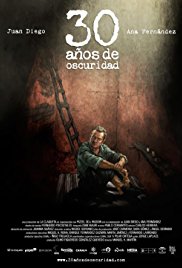Director: Manuel H. Martín 2012
Rarely do you find a documentary that is as engaging as 30 Years of Darkness which examines those men, I think all men, whom after the end of the war on April 1, 1939 some of these 'Moles" went in hiding for up to 32 years! The film uses a mixture of interviews with historians, family interviews, and illustrations in the style of graphic novels-which really works for this.
The main focus of the documentary is Manuel Cortes the former socialist Mayor of Mijas in Malaga Provence. After fleeing Mijas as Nationalist forces neared he joined the Republican Army.
After the war he was put in a camp with the other prisoners who were eventually released.
Manuel went home but there had been killings of other ex-mayors and it was decided that he would hide until it was safe to come out. First, he lived behind the wall in his father’s house, then for the first time in years he left the house dressed as an old women to walk to a new house his wife purchased were he lived under the stairs. Apart from the many sad aspects of this Manuel could only watch as his daughter grew up. Eventually she was let in the secret. Manuel and his wife and other "Moles" and their families were able to have children. Fabricated an extensive web of deceit to make it work. Finally there is one more move to a larger house-but he was still unable to attend his father’s funeral, daughter’s wedding, and grand daughter’s funeral.
In 1969, the Spanish dictatorship announced a general amnesty for all “crimes” and actions before April 1st, 1939. After some hard conversations with his wife it was decided that it was time to leave-after 30 years in hiding he walked out of the house without a chance he would be arrested or worse. The film has some wonderful family film of the time that shows Manuel and his wife Juliana ad their children and grand children. Very remarkable and moving to watch. Manuel lived until 1991!
Other ”Moles” are covered though not in such depth-Juan Hidalgo who went almost totally blind because of the decades he spent in hiding. Manuel Piosa who hid in the floor of a barn under straw and dung for three decades! In Segovia Santurnino de Lucas hid for 34 years! No one will ever know how many Moles there were. Many may have been shot the instant they were found, or died in their hiding places, killed themselves, escaped to another country, or who did survive.
The film is remarkable as it does an excellent job of showing how the people who lived through the war turned on each other, proved how much a dedicated Francoista they were by acting as informants, and the desperation of those who knew if caught they at the least be in prison for a long time-of more likely shot on the spot or in prison as a number of them were when they were discovered.
Rush to watch this film.



















































